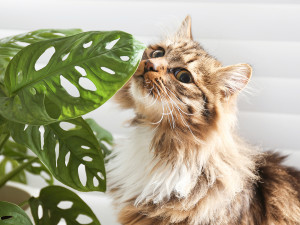10 Non-Toxic and Dog-Safe Houseplants
Brb... running out to buy air plants and succulents

Share Article
When adopting a new dog, there are a lot of things to worry about like making sure your pup gets the right nutrition opens in a new tab and trainingopens in a new tab. But what about dog-proofing your home? You might be surprised to learn that some common houseplants are toxic to both dogs and cats.
Over a quarter (28 percent, 4.6 million) of dog owners in the UK believe their pet has fallen ill after consuming something poisonousopens in a new tab. To keep your pup healthy, make sure the plants in and around your home are safe for them. Here are the best dog-safe, non-toxic houseplants to get you started (and be sure to check out this handy listopens in a new tab of toxic plants from the RSPCA).

littleKin™ is Kinship’s home just for puppy and kitten parents. Bop over to check out expert advice, new pet tools, and special deals—all curated for your newest family member.
opens in a new tab1. Spider plant
Chlorophytum comosum, commonly referred to as spider plants, are one of the most widely recognised and popular houseplants – and the good news is, they’re safe for dogs. These plants are popular for beginners because they are one of the easiest plants to care for. They don’t need a ton of attention and can thrive in almost any home. If you’re a novice looking for a pet-friendly starter plant, this should be your top choice.
2. Air plants
Commonly known as air plants, tillandsia are perfect for a home with pets: they are non-toxic to dogs, low maintenance and nicely decorative. Since they do not require soil to grow, they can fit just about anywhere. Tillandsia are commonly used as living-art pieces displayed on shelves, driftwood, small urns or hanging glass bulbs. Basically, they’re great anywhere your dog can’t reach them. But remember: low maintenance doesn’t mean no maintenance!
3. Boston ferns
Nephrolepis Exaltata, commonly known as the Boston fern, is a beautiful fern with a feather-like quality. True ferns, like the Boston fern, are typically non-toxic to dogs, and they make excellent houseplants. These graceful, easy-to-look-after ferns are great for hanging or the perfect accent to the top of a bookshelf. They do best with indirect sunlight and moist soil.
4. Staghorn fern
These unusual plants have two types of leaves: one heart-shaped and one that looks like the horns of a deer (hence the name). They are non-toxic to both cats and dogs, and they are easy to grow if you provide the right living conditions. Typically, these unique plants will be found mounted on a wall or draping from a hanging basket.
5. Maidenhair fern
Similar to the Boston fern, maidenhair ferns (Adiantum) are soft ferns with a fan shape and feather-like quality. Some might consider maidenhair ferns to be finicky, but they can be easy to care for once you learn the secret: water, water and more water. These plants love water so much that you practically cannot overwater them; add in a bit of bright light and you are set. These plants flourish in the right conditions, and since they are non-toxic to dogs and cats, they make a perfect addition to any home.
6. Prayer plant
The Maranta plant (Maranta leuconeura), also known as the ‘prayer plant’, has a unique ability: its oval-shaped leaves rise to an upright position during the night and the leaves fold together as if in prayer. These plants are easy to care for, do well in hanging baskets, and make for a great pet-safe houseplant.
7. Cat grass
Wheat-grass, also known as pet grass or cat grass, is actually quite nutrient-dense. It contains chlorophyll, fibre, vitamin E, phosphorus, magnesium, iron and potassium, plus some protein and carotenoids. Wheat-grass may also help pets with upset stomachs. It’s easy to grow and care for but does require clipping similar to a lawn.
8. Rosemary
Salvia rosmarinus, commonly known as rosemary, is an evergreen herb that is native to the Mediterranean. It requires a lot of sun (6–8 hours of full sun) and is sensitive to overwatering, so it can be tricky to care for indoors.
9. Ponytail palm
Beaucarnea recurvata, also known as elephant’s foot or ponytail palm, are easy to grow, provided you don’t overwater them. Kept indoors, they rarely get larger than four feet tall and can be started small and transplanted as they grow. Despite the name, the ponytail palm isn’t a true palm – it’s actually a part of the agave family.
10. Blue bird
This rosette-style succulent is not too fond of the cold, so it’s perfect for indoors. Place it in a sunny location like a windowsill, and lightly water it to maintain its beautiful colour.

Daniela Lopez
Daniela Lopez is a digital media specialist and long-time contributor to The Bark.
Related articles
![Red-haired woman holding sleeping dog in her lap on the bed]() opens in a new tab
opens in a new tab6 Reasons Your Dog Is Vomiting
And how to help them feel better fast
![cat sniffing a plant]() opens in a new tab
opens in a new tab9 Plants Toxic to Cats
These plants might be beautiful, but they’re deadly to feline foragers
![Dog looks up at owner on a walk through the city]() opens in a new tab
opens in a new tab7 Ways to Stop Your Dog From Scavenging On Walks
If your dog tries to wolf down literally everything in sight, you need this advice
![Kurzhaar's dog eats grass, oats, happy puppy playing in the meadow]() opens in a new tab
opens in a new tabWhy Do Dogs Eat Grass?
When to worry about your pup’s grass consumption (and when it’s not a problem)




